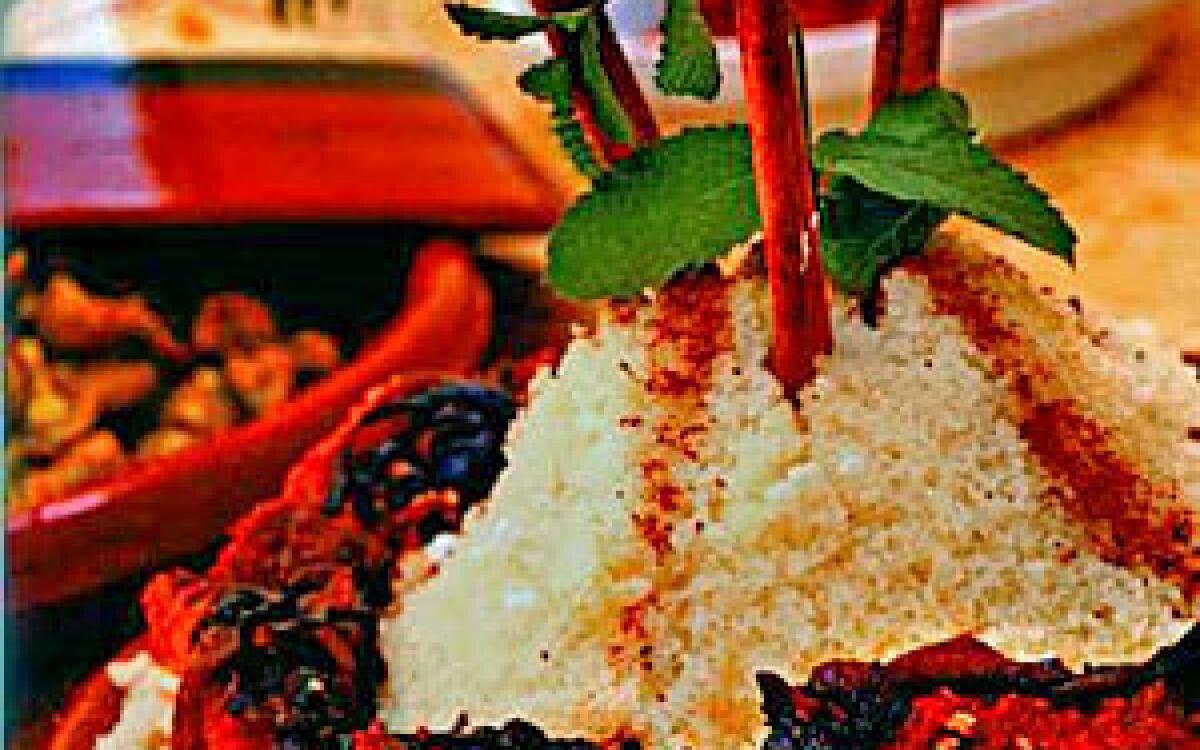Baked pumpkin jam with cinnamon and ginger

MAYBE THE evolution of the Israeli food scene over the last 25 years isn’t the first thing that crosses your mind when you think about contemporary Israel. Maybe you’re not even sure what Israeli cuisine is. But if it piques your interest, especially in this week before Rosh Hashana, the Jewish New Year, there’s a new coffee-table-worthy cookbook.
Janna Gur, founder and editor of a prestigious Israeli food and wine magazine, Al Hashulchan Gastronomic Monthly, has put together “The Book of New Israeli Food,” a beautiful, informative collection of photographs of Israeli life and food along with recipes and a series of essays by prominent Israeli food writers on such topics as cheese, wine, tahini, olive oil and the rise of Israel’s fish-farming industry in the wake of the collapse of the eastern Mediterranean’s fisheries. The book also has sections on Israel’s Jewish and Islamic religious holidays and includes recipes for dishes related to each.
Thanks to the diverse cultures that have contributed to Israel’s population, including Palestinian, Eastern European, North African, Mediterranean and Spanish via the Ottoman Empire (where Spanish Jews fled to during the Inquisition), the cuisine is a vibrant mix.
I loved the photographs and the way the book’s essays brought Israel so vividly to life. As I set out to cook from it, I was pleased to find that the metric conversions had already been done for American home cooks. Unfortunately, they proved more often than not to be wrong.
There were also a few odd mistakes, including a recipe for a beef dish that midway through mysteriously directs you to add the chicken, and odd lacunas on the subjects of baking-dish sizes and just what sauteed onions should look like -- transparent? Caramelized?
The appealing photo by Eilon Paz that accompanied a recipe for lamb patties baked in tahini sauce inspired me to try the recipe just as a friend asked me to supply the main dish for a potluck. I refused to be daunted by the book’s stern instructions to use only fresh tahini (and preferably only from Nablus or Nazareth).
The recipe also called for creating baharat, a Palestinian spice blend that included cardamom. I am not a great cardamom lover. More than a pinch produces a perfume-y taste that I don’t care for. But I dutifully added the called-for tablespoon to the blend of cinnamon, nutmeg and all.
Mercifully, more than half the guests turned out to be vegetarians. The patties were an unmitigated catastrophe -- oily, oddly dull in taste and redolent of cardamom -- and in no way resembled the glossy photograph.
One of the brave carnivores suggested that they were slightly more palatable if generously salted. My gracious hostess made the whole thing disappear.
Next I tackled a Shabbat apple cake for a dinner party with a whole new set of fierce foodies. This time the results were excellent, although the eggs -- despite a precise eight minutes of beating -- never quite lightened and thickened as called for. But the cake was a hit and did vaguely resemble the photo. So I forged ahead with a salad that called for a pinch of cinnamon in the dressing. It was subtle and very good.
For Rosh Hashana, The Times’ test kitchen adapted three recipes from “The Book of New Israeli Food,” adjusting times and temperatures: a honey cake (of course), an interesting Moroccan Jewish holiday side dish of pumpkin and couscous and a beet-pomegranate salad that’s not from the holiday chapter but showcases the pomegranates coming into season.
If you’re thinking of preparing the honey cake, start now: The cake improves if it’s allowed to “mature” a week so that the richness of the honey flavor deepens. This is also the time to experiment with an artisan or specialty honey that will give your cake an even more refined taste.
As for the book, I still love it. It’s a door into the life of present-day Israel, and it made me want to pack immediately and revisit the land of pomegranates, dates and honey.
It’s too bad that some of the recipes seem almost thrown together, but for a confident, freewheeling cook, it could still be a road map to good eating.
Heat the oven to 325 degrees.
In a medium, heavy-bottom fry pan heated over medium heat, add the olive oil and onion. Gently cook until the onion caramelizes, about 20 minutes, stirring frequently. Stir in the sugar and continue to cook until the sugar dissolves. Stir in the cinnamon, ginger and thyme sprigs. Finally, stir in the chopped pumpkin.
Place the pumpkin mixture in a 13-by-9-inch baking dish. Bake the pumpkin until it is tender and slightly caramelized, 45 to 50 minutes, stirring every 15 minutes. Remove and discard the thyme sprigs.
While the pumpkin is baking, prepare the couscous according to the manufacturer’s instructions.
To serve, mound the couscous in the center of a large platter and garnish with the pumpkin.
Get our Cooking newsletter.
Your roundup of inspiring recipes and kitchen tricks.
You may occasionally receive promotional content from the Los Angeles Times.















